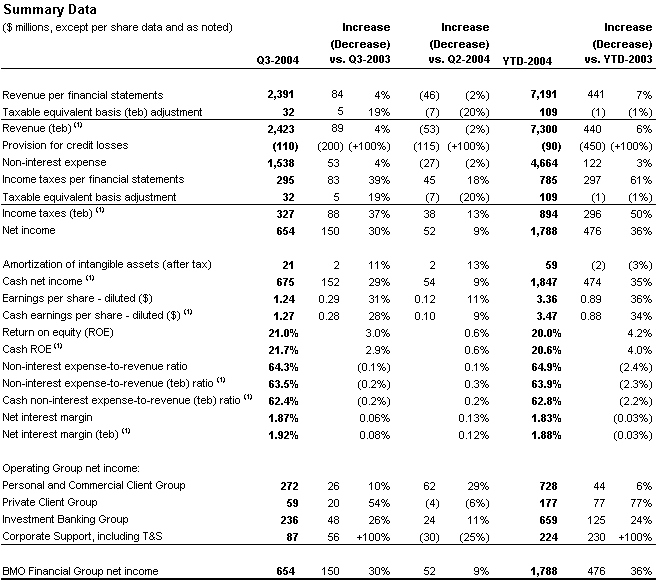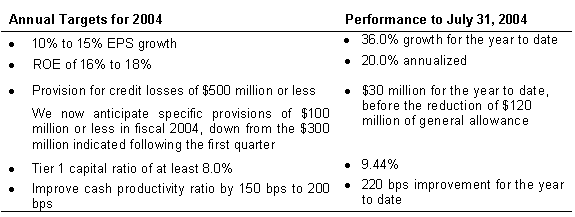News Releases
|
Improved Credit Performance and Increased Business Volumes Drive Growth Year-over-Year Operating Highlights for the Quarter:
Year-over-Year Operating Highlights for the Year to Date:
Other Highlights:
1 All Earnings per Share (EPS) measures in this release refer to diluted EPS unless specified otherwise. 2 The adjustments that change results under generally accepted accounting principles (GAAP) to cash results and GAAP revenue and income taxes to a taxable equivalent basis (teb) are outlined in the Non-GAAP Measures section in the Financial Performance Review, where all non-GAAP measures and their closest GAAP counterparts are outlined. Revenues and income taxes in the financial statements are stated in accordance with GAAP. Otherwise, all revenues and income taxes and measures that include revenues or income taxes in this document are stated on a taxable equivalent basis. Bank of Montreal uses a unified branding approach that links all of the organization's member companies. Bank of Montreal, together with its subsidiaries, is known as BMO Financial Group. As such, in this document, the names BMO and BMO Financial Group mean Bank of Montreal. THIRD QUARTER 2004 MANAGEMENT'S DISCUSSION AND ANALYSIS OF OPERATIONS AND FINANCIAL CONDITION (MD&A)
(1) These are non-GAAP amounts or non-GAAP measures. Please see footnote 2 to the previous table and the Non-GAAP Measures section in the Financial Performance Review, which outline the use of non-GAAP measures in this MD&A. Toronto, August 24, 2004 - BMO Financial Group reported that its net income for the third quarter ended July 31, 2004 was up 30% from a year ago. PERFORMANCE OVERVIEW Net income increased $52 million or 9% from the second quarter of 2004 and EPS increased $0.12 per share or 11%. The increase was driven by a $115 million ($75 million after tax) improvement in the provision for credit losses. Origination fees and trading revenue declined, but there was strong volume growth in personal and commercial banking. Year to date, net income of $1,788 million was up $476 million or 36% from the comparable period in 2003. Improved credit performance contributed significantly to net income growth, as the provision for credit losses was down $450 million ($293 million after tax) from the comparable period a year ago. In addition, business volumes were up strongly and net income of each of the operating groups was higher than a year ago. Private Client Group net income of $177 million was up $77 million or 77% from the comparable period in 2003, while Investment Banking Group net income of $659 million was $125 million or 24% higher, as both benefited from the more favourable capital markets environment. Personal and Commercial Client Group net income of $728 million was $44 million or 6% higher. The benefits of the group's volume growth were only partially offset by the impact of lower net interest margins in the competitive low interest rate environment. Revenue1 for the quarter increased $89 million or 4% from a year ago to $2,423 million. The growth was attributable to improved business volumes, including the impact of acquired businesses, and interest received on loans that were previously impaired or written-off, partially offset by the effects of lower net interest margins in personal and commercial banking and a slightly weaker U.S. dollar. Revenue was down $53 million or 2% from the second quarter, despite two more calendar days in the current quarter. Private Client Group revenue declined because of lower securities trading commissions. Despite higher interest received on previously impaired or written-off loans, Investment Banking Group revenue declined, as this group was also affected by lower securities trading commissions, and reduced underwriting fees. The Group's second quarter revenues included higher net investment securities gains but they were largely offset by interest expense incurred on the unwinding of related hedge contracts. Revenue also fell in the Corporate Support Group, as net investment securities gains were $54 million lower and foreign exchange translation gains declined. Personal and commercial banking revenues were higher in both Canada and the United States, driven by volume growth. Second quarter Personal and Commercial Client Group revenue included a $51 million adjustment to reduce card fees. Year to date, revenue rose $440 million or 6%, driven by higher personal and commercial banking volumes, strong growth in securities trading commissions and underwriting fees, and net gains on investment securities, compared with net losses a year ago. Acquired businesses also contributed to the growth. These increases were partially offset by the card fees adjustment, lower securitization revenue and the impacts of lower net interest margins and the weaker U.S. dollar. Net interest margin1 for the third quarter of 2004 was 1.92%, an increase of 8 basis points from a year ago. Net interest margin was higher in Investment Banking Group, which benefited from interest received on loans that were previously impaired or written-off. Net interest margin was lower in the other operating groups, because of shifts in customer preferences to low spread products and the competitive low interest rate environment. Higher net interest margin in Investment Banking Group drove an overall 12 basis points increase from the second quarter. Margins rose slightly in personal and commercial banking, as a small increase in Canada offset a decline in the United States. Net interest margins are detailed in the Revenue section of the Financial Performance Review. Non-interest expense of $1,538 million was $53 million or 4% higher than a year ago. The increase was largely attributable to higher performance-based compensation costs and the incremental impact of acquired businesses. The non-interest expense-to-revenue ratio1 (productivity ratio) was 63.5% in the third quarter, compared with 63.7% a year ago. The cash productivity ratio1 of 62.4% improved 20 basis points from a year ago. Year to date, the cash productivity ratio of 62.8% improved 220 basis points from a year ago. Our target at the start of the year was to improve cash productivity by 150 to 200 basis points in 2004. This quarter's results included a $70 million net recovery of specific credit losses, compared with a specific provision of $90 million in the third quarter of 2003. The improvement reflects low levels of new provisions, relatively high levels of reductions of previously established allowances on certain loans and $60 million of recoveries on loans previously written-off, including a $39 million recovery on a single account. During the quarter, we repurchased 3,055,100 Bank of Montreal common shares under our common share repurchase program at an average cost of $53.25 per share for a total of $162.7 million. Under the program, which expired on August 6, 2004, there were 5,123,900 shares repurchased at a total cost of $271.3 million. On August 6, 2004, BMO announced a new normal-course issuer bid under which BMO may purchase for cancellation up to a further 15 million common shares. ____________________ 1 On a taxable equivalent basis -- see the Non-GAAP Measures section
2004 Economic Outlook Management's Responsibility for Financial Information As in prior quarters, BMO's audit committee reviewed this document, including the attached unaudited interim consolidated financial statements, and BMO's Board of Directors approved the document prior to its release. A comprehensive discussion of our businesses, strategies and objectives can be found in Management's Discussion and Analysis of Operations and Financial Condition in BMO's 2003 Annual Report, which can be accessed on our web site at www.bmo.com/investorrelations. Readers are also encouraged to visit our web site to view quarterly financial information. Regulatory Filings To view the rest of this news release consisting of:
CAUTION REGARDING FORWARD-LOOKING STATEMENTS By their nature, forward-looking statements require us to make assumptions and are subject to inherent risks and uncertainties. There is significant risk that predictions and other forward-looking statements will not prove to be accurate. We caution readers of this document not to place undue reliance on our forward-looking statements as a number of factors could cause actual future results, conditions, actions or events to differ materially from the targets, expectations, estimates or intentions expressed in the forward-looking statements. The future outcomes that relate to forward-looking statements may be influenced by many factors, including but not limited to: global capital market activities; interest rate and currency value fluctuations; the effects of war or terrorist activities; the effects of disease or illness that impact on local, national or international economies; the effects of disruptions to public infrastructure, such as transportation, communications, power or water supply disruptions; industry and worldwide economic and political conditions; regulatory and statutory developments; the effects of competition in the geographic and business areas in which we operate; management actions; and technological changes. We caution that the foregoing list of factors is not exhaustive and that when relying on forward-looking statements to make decisions with respect to Bank of Montreal, investors and others should carefully consider these factors, as well as other uncertainties and potential events, and the inherent uncertainty of forward-looking statements. Bank of Montreal does not undertake to update any forward-looking statement, whether written or oral, that may be made, from time to time, by the organization or on its behalf. INVESTOR AND MEDIA PRESENTATION Investor Presentation Materials Quarterly Conference Call and Webcast Presentations A live webcast of the quarterly conference call can be accessed on our web site at www.bmo.com/investorrelations. A replay can be accessed on the site until Monday, November 22, 2004. Media Relations Contacts Investor Relations Contacts Chief Financial Officer Corporate Secretary |


